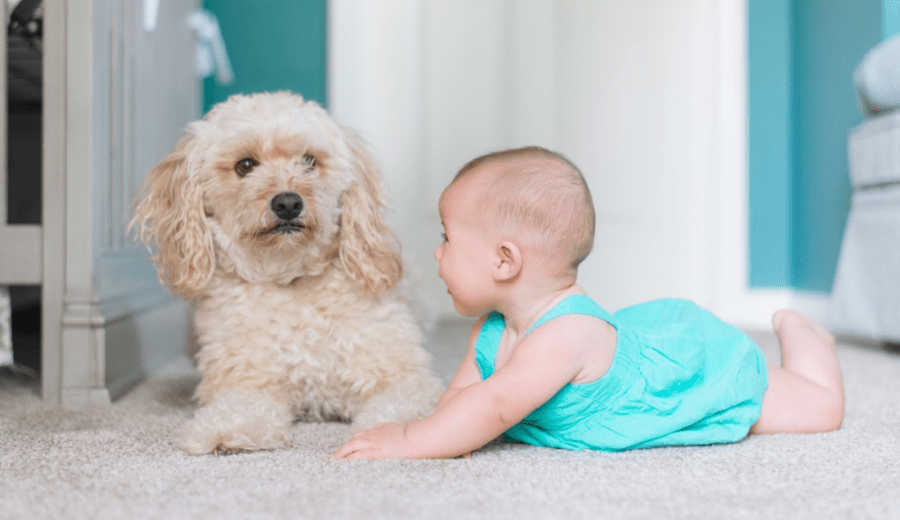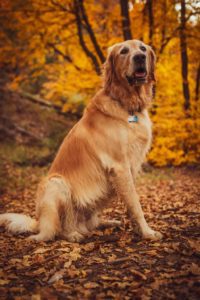Look at this picture. You’ve seen hundreds like it on social media. Adorable, right? Cute baby playing with her dog, the dog lying down nicely as she approaches . . .
 Actually, this photo is far from innocent and safe.
Actually, this photo is far from innocent and safe.
This dog is EXTREMELY uncomfortable, and as parents, it is our responsibility to prevent this scenario from happening. This photo reveals, my friends, how incidents happen between dogs and children.
As a dog trainer specialized in dogs and children and a Licensed Family Paws Parent Educator, I am passionate about educating families about safety.
Let’s look at this picture a little closer. Our first clue that this dog is uncomfortable is the way it is leaning away from the approaching child. Children should never approach dogs like this. Notice how the dog is essentially cornered in this scenario. It can’t move forward because the baby and camera/photographer are in the way. It can’t go to either side because of the crib and the baby, and it may be able to go backward, but would have to shift focus from everything going on around it.
Notice the dog’s face. This is also very important. This dog is looking intensely at what I am assuming is its owner, and its face is extremely tense. Fixed stare, closed mouth, tense face. All signs of stress and discomfort.
If you’re realizing that you have a few pictures like this on your social media pages, you’re not alone. Also, you’re not a bad parent! Let’s talk about how we can do better for both our dogs and our children. This applies to dogs we own, but also to dogs we don’t know.
First of all, take a look at this example of a relaxed dog.

How do we know this dog is relaxed? We need to look at its entire body. Let’s start with the face. The ears are relaxed. The eyes are not intense. The muscles of the nose and jaw are relaxed. For most dogs, a slightly opened mouth is a relaxed position. Look at the dog’s shoulder and back muscles. They are not bulging or super tensed up. If they were tense, you’d see more bulge and tension in the back. Although we can’t see much of the tail, it’s very important to remember that a wagging tail does not indicate a happy dog. Dogs will wag their tail like crazy when they are nervous. So it’s important to look at the whole dog.
When you start to pay close attention to the signals your dog is giving, you will begin to understand what makes them uncomfortable and can intervene as appropriate. There are different strategies depending on whether you have babies or older children in your home. Follow the links for more detailed information.
So what about strange dogs? How do we keep our children safe around dogs we don’t know?
Well, if you decide to allow your child to pet a dog you don’t know, use what you have learned about stress body language to decide how the dog feels about interacting. If you think they’re not so into it, say no to petting. Even if the owner says that the dog is fine, trust your judgment. When your child does pet the dog, make sure they pet on the back between the shoulders and that they pause after a couple of pets to see if the dog wants more.
What if a strange dog off-leash comes running up to your child? Teach your child to STAY STILL. The dog will not be interested if the child is not moving. If they stand with their chin down, looking at the ground, arms crossed or by their side, and not moving, the dog will sniff them and move on. The worst thing anyone can do when a strange dog approaches is run, flail their arms, or panic. Dogs feed off of our energy. Check out the website for Doggone Safe for more great tips and videos.
Teaching our children about safety around dogs is so important.
We need to educate ourselves as well so that identifying safe scenarios and stress becomes second nature. That way our children can have a great relationship with their dog based on understanding and respect.
For more information on child safety around dogs, take a look at the websites for Family Paws Parent Education, Living with Kids and Dogs, and the Pawsitively Waggin Facebook Page.
Originally published April 2019.
The opinions expressed in this post are those of the author. They do not necessarily reflect the official policy or position of ABQ Mom, its executive team, other contributors to the site, its sponsors or partners, or any organizations the aforementioned might be affiliated with.











